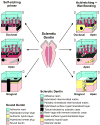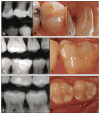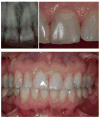Durability of bonds and clinical success of adhesive restorations
- PMID: 22192252
- PMCID: PMC3863938
- DOI: 10.1016/j.dental.2011.09.011
Durability of bonds and clinical success of adhesive restorations
Abstract
Resin-dentin bond strength durability testing has been extensively used to evaluate the effectiveness of adhesive systems and the applicability of new strategies to improve that property. Clinical effectiveness is determined by the survival rates of restorations placed in non-carious cervical lesions (NCCL). While there is evidence that the bond strength data generated in laboratory studies somehow correlates with the clinical outcome of NCCL restorations, it is questionable whether the knowledge of bonding mechanisms obtained from laboratory testing can be used to justify clinical performance of resin-dentin bonds. There are significant morphological and structural differences between the bonding substrate used in in vitro testing versus the substrate encountered in NCCL. These differences qualify NCCL as a hostile substrate for bonding, yielding bond strengths that are usually lower than those obtained in normal dentin. However, clinical survival time of NCCL restorations often surpass the durability of normal dentin tested in the laboratory. Likewise, clinical reports on the long-term survival rates of posterior composite restorations defy the relatively rapid rate of degradation of adhesive interfaces reported in laboratory studies. This article critically analyzes how the effectiveness of adhesive systems is currently measured, to identify gaps in knowledge where new research could be encouraged. The morphological and chemical analysis of bonded interfaces of resin composite restorations in teeth that had been in clinical service for many years, but were extracted for periodontal reasons, could be a useful tool to observe the ultrastructural characteristics of restorations that are regarded as clinically acceptable. This could help determine how much degradation is acceptable for clinical success.
Copyright © 2011 Academy of Dental Materials. Published by Elsevier Ltd. All rights reserved.
Figures







References
-
- Buonocore MG. A simple method of increasing the adhesion of acrylic filling materials to enamel surfaces. J Dent Res. 1955;34:849–53. - PubMed
-
- Brudevold F, Buonocore M, Wileman W. A report on a resin composition capable of bonding to human dentin surfaces. J Dent Res. 1956;35:846–51. - PubMed
-
- Cardoso MV, de Almeida Neves A, Mine A, Coutinho E, Van Landuyt K, De Munck J, Van Meerbeek B. Current aspects on bonding effectiveness and stability in adhesive dentistry. Aust Dent J. 2011;56(Suppl 1):31–44. - PubMed
-
- Perdigao J. Dentin bonding-variables related to the clinical situation and the substrate treatment. Dent Mater. 2010;26:e24–37. - PubMed
Publication types
MeSH terms
Substances
Grants and funding
LinkOut - more resources
Full Text Sources
Other Literature Sources

